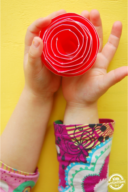You worked hard on your science fair project. Now it’s time to display the project on a science fair poster! But what exactly goes on a poster and what makes one poster stand out from the rest? Keep reading for answers to all your science fair display questions.

Step-by-Step Guide for Making a Great Science Fair Poster
Thinking of a great science fair project idea is the first step in participating in a science fair. Check out these ideas for kids of all ages by Kids Activities Blog! After you complete the project, you will need to display the project in a way that is clear and interesting. This post provides tips for making a great project board from start to finish!

What materials you need for the poster
Before you start making your poster, you will need to gather all your materials.
-
Three-panel science fair poster board
This is the foundation of your display. Using a three-panel board is the best way to showcase your project unless otherwise noted in competition rules. Standard science fair poster board dimensions are 48-inches wide by 36-inches tall. You can find these boards almost everywhere that has office, school, or craft supplies!
-
Markers
You will need thick and fine-tipped permanent markers for different aspects of your display! It’s helpful to use a variety of colors. Be sure your marker colors contrast with the color of your project board so your writing is visible from a few feet away.
-
Print-outs
It is a good idea to capture and print photos as you work on different steps of the project. You will also print out data and other helpful graphics.
- Tape or glue
- Scissors
- Ruler
- Pencils with erasers
What sections to include on the poster
Your science fair might require specific sections to be included on the poster, so be sure to check the instructions first! If not, the sections listed below are a safe bet for any science poster presentation.
-
Title
The best titles are descriptive, clear, and attention-grabbing! Check out titles of winning science fair projects via Business Insider. Be sure to display the title in a large, easy-to-read font!
-
Abstract
An abstract is a condensed version of your project. Everything the audience needs to know about your project should be there! Check out resources from ThoughtCo, Science Buddies, and Elemental Science.
-
Purpose Statement
Your purpose statement should explain, in one or two sentences, the goal of your project. Find examples of effective and ineffective purpose statements via University of Washington.
-
Hypothesis
A hypothesis is a possible answer to a scientific question that you can test. It’s the foundation of your science project! Check out how to write a strong hypothesis at Science Buddies.
-
Method
This section of your display should answer the question, “How did you do your project?” Think of it as the recipe for your experiment. Someone else should be able to follow the recipe to re-create your project! Because you want this section to be easy to follow, it’s helpful to number each of your steps.
-
Materials
In this section, you should list each of the materials you used. Did you need an apple? List it! 4 tablespoons of peanut butter? List it! (It’s possible I am hungry.)
-
Data
Data are easiest to understand when displayed in graph form! Check out this kids tutorial created by the National Center for Education Statistics.
-
Results
This is where you test your hypothesis with your data and summarize what you found. The results section is best displayed in graph form.
-
Conclusions
In the conclusion section you will need to summarize the project. The RERUN method might help!
R=Recall. Answer, “What did I do?”
E=Explain. Answer, “What was the purpose?”
R=Results. Answer, “What were my findings? Did the data support or contradict my hypothesis?”
U=Uncertainty. Answer, “What uncertainty, errors, or uncontrolled variables remain?”
N=New. Answer, “What did I learn?”
-
Bibliography
This is your reference section. Be sure to use the correct formatting style for your science fair.
How to design the poster to look great and stand out
Now give that poster some personality! Check out examples from MomDot for inspiration and then follow these tips!
-
Format
You can either write or type and print the text for the poster. In either case, consider your font style and size choices. Your text should be large and clear. Check out these tips from The Molecular Ecologist!
-
Layout
It’s important for the sections on your poster presentation to flow logically. Use these examples from Science Fair Extravaganza to get you started.
-
Images and Graphics
The best posters will include images, charts, and pictures. Take actions shots while you work on the project. Then, place these images in the procedure section. Be sure to include graphs in your data and results sections. Finally, work on an image that represents the big picture of your project for the conclusion section.
-
Color and Decorations
Last, but not least, think about color and decorations for your poster. Make sure your markers and print-outs contrast with the board. Since your board will most likely be white, your print and designs should be dark. Then, use different colors to make titles and key words stand out. You can also use colors to connect key words or concepts with each other across the board.
Make sure your decorations enhance, rather than distract, from the content on the board. For instance, you could create fun borders for different sections of the poster or draw arrows that connect one section to the next!
Join in the comment section to tell us how your poster turned out!























0